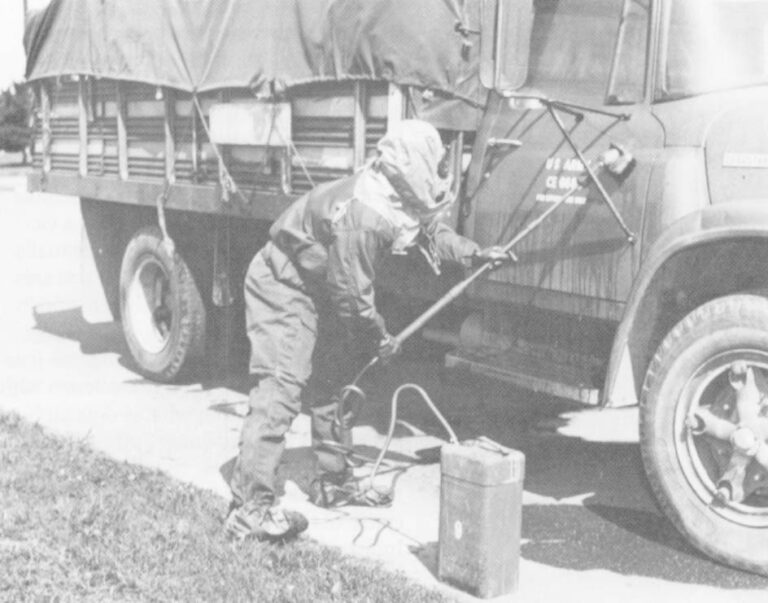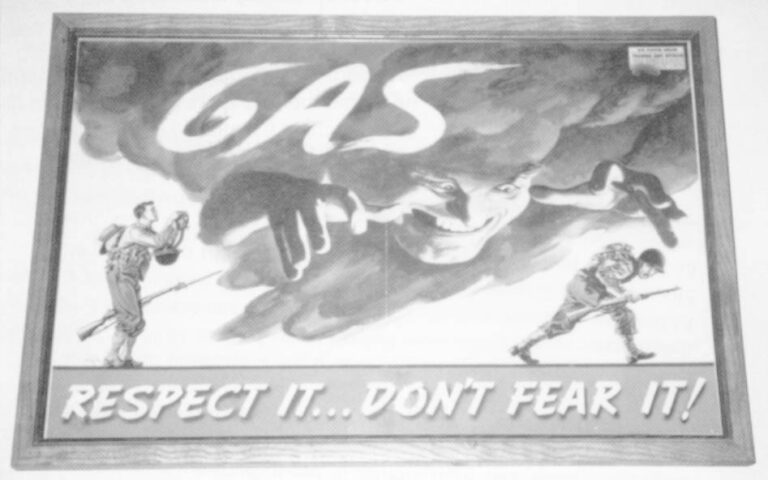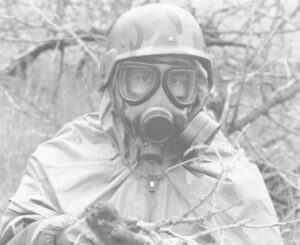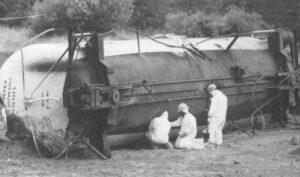WASHINGTON-For Gen. H. Norman Schwarzkopf, it would have been a hellish dream come true-allied ground troops pinned down by Iraqi forces and pummeled with chemical rockets and artillery. At his briefing in Riyadh, Saudi Arabia on Feb. 27, the fourth day of the ground war in the Persian Gulf, Schwarzkopf pointed at a chart showing penetration lines in the campaign to liberate Kuwait. Colored symbols represented the advancing 1st and 2nd Marine divisions and the Army’s 2nd Armored Division’s “Tiger Brigade.” They were pushing into Kuwait southwest of Al Jahrah, about 40 miles from the Gulf. “The nightmare scenario for all of us would have been to go through, get hung up in this breach right here and then have the enemy artillery rain chemical weapons down on troops that were in a gaggle in the breach right there,” he said. The allied commander later added, “We had a lot of questions about why the Iraqis didn’t use chemical weapons, and I don’t know the answer. I just thank God that they didn’t.”

Many experts, military and civilian, had predicted the war against Saddam Hussein would produce the fiercest chemical battleground since World War 1. After all, Iraq had used chemicals in its eight-year war with Iran and against its Kurdish rebels. Accordingly, in the warm-up months of Operation Desert Shield, the Pentagon rushed more than 1.5 million chemical defensive overgarments, complete with gas mask and antidote sets, to U.S. troops in the region. Israel, as a hedge against chemical attacks from Iraqi Scud missiles, issued gas masks to every man, woman and child in the country-4.5 million all told. Even in New York City, as a reaction to possible terrorism, masks sold briskly at military surplus stores. But Desert Storm ended without a wisp of toxic clouds.
Despite that surprising outcome-and even as diplomats in Geneva try to hammer out a global ban on the manufacture and possession of war poisons-gas masks clearly are here to stay. Iraq retained a chemical weapons cache of uncertain size in the aftermath of the war, including hundreds of tons of mustard agent, sarin and tabun nerve agents and chemical ingredients. Until those are destroyed, they represent a potential threat. The owners of the largest chemical stockpiles, the United States and Soviet Union, have agreed bilaterally to destroy a large majority of their existing weapons and to produce no more. But some 20 other nations have confirmed or suspected chemical arsenals, according to the Central Intelligence Agency.
While contemporary chemical defense never underwent its battlefield baptism, the Gulf war may have added momentum to one important reassessment: the right of “retaliation in kind” to a chemical attack. That right is reserved by the United States, in its acceptance of the 1925 Geneva Protocol. But the political price of such a counterpunch, even against the likes of Saddam, would be high. President Bush promised a severe response to any chemical attack by Iraq, but it’s not clear what he had in mind. A tactical nuclear strike? Intensified conventional bombing? “Clearly, it is not in the country’s interest to lay out courses of action before they have to be taken,” says Billy Richardson, deputy assistant to the secretary of defense for chemical matters.
“I cannot conceive of a situation in which the United States would want to use chemical weapons,” Defense Secretary Dick Cheney said at a news conference at Fort Stewart, Georgia, two weeks after the invasion. Later, in separate television interviews, Vice President Dan Quayle and White House Chief of Staff John Sununu spoke against a chemical response. Some critics felt Quayle and Sununu were unwise to publicly limit U.S military options. In fact, there never were any U.S. chemical weapons in the Kuwaiti theater of operations.
In a major policy reversal, Bush on May 13 announced that the United States was forswearing the use of chemical weapons for any reason, including retaliation, once a global ban on possession and production takes effect. He also said the United States would destroy its entire chemical stockpile once the treaty is in force. The administration previously had said it would keep a small part as insurance until all nations capable of producing chemical weapons had joined the treaty.
While chemistry has been bent to the purposes of war since ancient times–poisoning an enemy’s well with an animal carcass, for instance–chemical weapons were first used on a large scale in the trenches near Ypres, Belgium, in April 1915. Billows of chlorine from the German lines routed the opposing French and Algerian troops. Had the Germans been prepared for the dramatic effects of the gas, the Kaiser might be living in London. But they had failed to assemble enough reinforcements to exploit a victory. The French, British and eventually Americans developed chemical arsenals of their own, principally mustard, which blisters skin, eyes and lungs. A equally gruesome concoction was phosgene (carbonyl chloride), which fills the lungs with bodily fluids, causing what is delicately called “dryland drowning.” After the initial surprise at Ypres, chemicals failed to become a decisive factor in the war because of the effectiveness of gas masks. Indiscriminate and unnecessarily cruel, the World War I agents triggered such revulsion that their use was banned under the 1925 Geneva Protocol.

Fifty years passed before the United States ratified the agreement. Excluded under the U.S. interpretation are tear gases and other “riot-control” agents, as well as smoke and incendiary compounds such as white phosphorus and napalm, and herbicides such as Agent Orange. The treaty, agreed to by 130 countries, including Iraq, does cover the pesticide-like nerve agents discovered by Germany in 1936 but never used in World War II. These agents, called organophosphates act by inhibiting cholinesterase, an enzyme that allows contracted muscles to relax. The result of exposure is pinpoint pupils and, with greater doses, nausea, defecation, convulsions, coma and death. Nerve agents, usually liquids, come in two broad categories: persistent, meaning they are viscous, like motor oil, and don’t evaporate readily, and non-persistent, meaning they will evaporate in a matter of minutes in warm weather.
A related arena is that of biological weapons, often referred to as germ warfare, but covering far more than disease-causing bacteria and viruses. (Anthrax, botulism, cholera, etc.) Stampeding a herd of buffalo through an enemy camp would qualify as biological warfare, as would planting a poisonous snake in someone’s bed. Naturally occurring toxins fill the pages of spy lore. When his U2 reconnaissance plane was shot down over the Soviet Union in 1960, Francis Gary Powers carried saxitoxin, the poison found in a sea algae known as red tide, on the tip of a drill bit hidden inside a silver dollar. He apparently opted against suicide. More recently, in 1978, Bulgarian dissident Georgi Markov was killed with ricin, a highly toxic compound from the castor bean plant. The murder weapon was an umbrella, which planted a ricin-laced pellet in Markov’s thigh as he crossed London’s Waterloo Bridge.
The United States stopped making biological weapons in 1969, and three years later an international treaty banned their manufacture and possession, although research into vaccines and other defenses is permitted.
The failure of the Iraqi army to let slip the chemical dogs of war has been one of the bigger mysteries in the uneasy aftermath of Desert Storm.
Among the possible explanations: the Iraqis themselves had poor protective equipment; they feared U.S. chemical or tactical nuclear retaliation; the wind was blowing toward the Iraqi lines; the air war had destroyed Iraqi supply lines necessary to bring chemical weapons to the front; the chemical agents themselves deteriorated and Saddam’s forces were unable to restock because the production plants had been hit hard in the air campaign. Schwarzkopf speculated: “We went after their artillery big time. They had major desertions in their artillery, and that’s how they would have delivered the chemical weapons. Either that or by air, and we all know what happened to the air.” Also unknown was the extent of environmental contamination from the destruction of the Iraqi chemical and biological weapons plants. But Pentagon officials said it is unlikely that Baghdad would be able to restore the chemical weapons assembly lines, built in the 1980s with help–often illegal–of companies from Germany and other western countries.
Although some hurdles remain in the path of a multilateral Chemical Weapons Convention, some observers predict that the 39 participating nations (down from 40 with the reunification of Germany) may have a treaty available for signature in 1992. “This convention, once completed–hopefully in the next two years or so–will delegitimize chemicals weapons,” says Elisa D. Harris of the Brookings Institution.

Even as progress in made toward a global chemical weapons ban, chemical defense remains high on worldwide military agendas. There is no guarantee that every nation will agree to or abide by such a treaty. Chemical weapons have proven useful against unprepared civilians, poorly equipped rebel forces and inadequately trained troops. But good training and defensive equipment dramatically reduce the advantages of a chemical attack. “The better a force is protected against chemicals, the less incentive there will be for a chemically-armed adversary to initiate chemical warfare,” says Matthew Meselson, professor of biochemistry and molecular biology at Harvard University and an authority on chemical and biological agents. “Indeed chemical warfare has never been initiated against forces with adequate anti-chemical protection.” Moreover, Meselson argues, modern protective equipment is so effective that it holds important policy implications. “The incentive for a potential cheater to cheat is much less,” he says. “But if I do really want to cheat, I have to cheat bigger, because if you are well defended, I need an awful lot more stuff before my advisers will tell me it has any military significance. But if I cheat bigger, then it is more likely to be seen, more conspicuous. So chemical defense actually helps verification.”
Chemical defense is also big business. The 1990-91 edition of Jane’s NBC Protection Equipment (price: $135) lists 184 manufacturers from more than 20 countries. The gear includes antidotes to nerve agents, air-sniffing monitors and alarms, reconnaissance vehicles, decontamination kits, protective masks and suits and field hospitals. Italy, for instance, markets a portable field shower. Canada and France make hermetically sealed body bags. Yugoslavia still makes masks for horses.
The mask currently used by American soldiers, the M-17, became a focus of heated controversy during Desert Storm. Contract problems delayed the manufacture of the M-40 mask intended to replace the M-17, and the Pentagon took some flak sending forces to face Saddam with less than the best protection. Granted, the M-40 has a better face seal, a voice box for better communication and a screw-on filter that’s easier to change. The filter is also off to one side, so that it doesn’t get in the way when a soldier is talking on the telephone or aiming a rifle. But at least one report, the Jan. 31 segment of ABC’s Primetime Live, badly misrepresented the advantages of the M40’s easy-to-change air filter. Noting that the filter “could be changed in seconds,” correspondent Chris Wallace added, “With the M-17, you have to take off the mask to change filters because they’re buried inside.” That suggests that the M40 filter can be changed while the soldier is in the middle of a toxic cloud. Not true. Taking off the filter leaves a hole in the mask, exposing the soldier to the outside air. So with either mask, the filter must be changed in a uncontaminated environment. Meselson and Army officials note that the M-17 has been used safely and successfully by 17,000 service personnel trained in a chamber containing sarin (or GB) nerve gas at the U.S. Army Chemical School at Fort McClellan, Alabama.
Chemical protective equipment carries its own set of nasty problems, of course. The masks cut a soldier’s field of vision and ability to communicate. The suits can be hot and conducive to claustrophobia.

Drinking through the mask becomes easy with practice, but getting rid of bodily wastes is such a chore that soldiers are more likely to soil their suits than go through it. “Anybody that has been exposed to the area knows that you get significant degradation in defensive posture,” says Richardson, the Pentagon’s chemical czar. “Studies have shown, particularly in the Air Force and Army but in all services to some extent, in varying tasks you get 30 to 50 percent degradation… If you reduce Air Force sorties by 50 percent by use of chemicals, that’s just like taking out aircraft.”
A study by the Army based on field exercises at Fort Hunter Liggett, California, in the spring of 1983, found that casualties per enemy attack increased 75 percent in a nuclear or chemical environment. Wearing so-called “NBC” (nuclear-biological-chemical) protective gear also increases the number of casualties from “friendly fire.” That doesn’t appear to have been a big problem in Desert Storm, where most “friendly fire” casualties related to poor coordination between air and ground units. But the Army study showed that fully a fifth of shots fired from M-16s were aimed at friendly personnel in gas masks.
The Army says training is the key, but chemical warfare training in the United States historically has fallen in and out of fashion. The chemical school, which trains personnel from all military branches in NBC defense and detection, was closed in the 1970s, then reopened at McClellan in 1980. On April 12, Defense Secretary Cheney announced his decision to close McClellan and 30 other major military bases. But Congress has supported a recommendation by a federal commission that spares McClellan and its $14.2 million Chemical Decontamination Training Facility, which opened four years ago.
The search for new threats and countermeasures continues, meanwhile.
The U.S. program in defensive technology and equipment is based at the Chemical Research, Development and Engineering Center at Aberdeen Proving Ground, Maryland, northeast of Baltimore. “Both the magnitude and the diversity of the chemical threat increasingly confront our servicemen in assignments around the world,” says Brig. Gen. David Nydam, the center’s commanding general. “New technologies on the frontiers of science contribute to both the problem and the solution.”
These frontiers include mass spectrometry and biotechnology for the detection and identification of chemicals; enzymes for decontamination; plasmas and catalysts to replace charcoal for the filtration of contaminated air; and computer models to study the behavior of aerosols. At the U.S. Army Medical Research Institute of Chemical Defense, also at Aberdeen, scientists and laboratory technicians are looking for new drugs and treatment procedures against chemical agents. These include pretreatments and antidotes, cleansing solutions, methods of skin protection and new ideas about the management of casualties.

Among its top technical objectives, the Army’s chemical research establishment wants above all to avoid surprise by the enemy–a technological Pearl Harbor. Toward that end, laboratory and field work will march ahead despite the apparent end of the Cold War and the lack of obvious Third World adversaries. Who after all, could have predicted Schwarzkopf s “nightmare scenario” a year ago? The specter of future Saddams is likely to keep the business of NBC flourishing well beyond the destruction of the U.S. and Soviet chemical arsenals and conclusion of successful diplomatic efforts in Geneva.
©1991 Jim Borg
James Borg, a freelance science writer based in Honolulu, is examining the use and disposal of chemical weapons worldwide.




